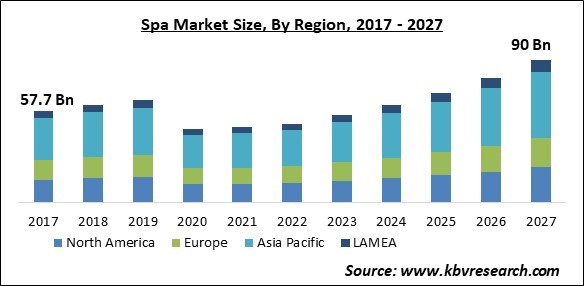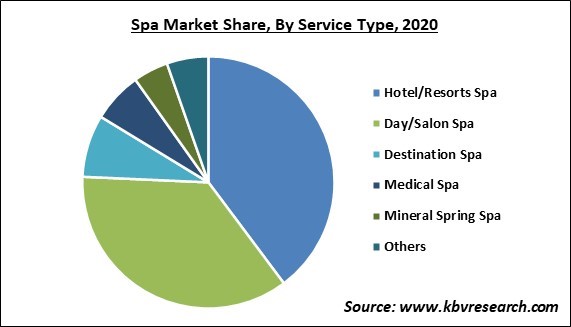The Global Spa Market size is expected to reach $90 billion by 2027, rising at a market growth of 11.2% CAGR during the forecast period.
A spa is a commercial establishment that offers health management and relaxing services to the public. Massages, body cleanse, steam baths, facials, sauna baths, manicures, and pedicures are just a few of the therapeutic treatments available. Day spas, hotel and resort spas, destination spas, medical spas, and mineral or thermal spas are the most prevalent providers. These establishments also provide customized anti-aging and de-stressing treatments that are good for stress management, medical illnesses, body detoxification, weight management, and immune system boosting.
Factors such as the expanding female population and anti-aging spa treatments will add a considerable number of prospective customers to the spa market. For example, Starwood Hotels is building 65 spas in the area, while Hilton Worldwide is planning 124. With the introduction of software-based management systems, massage centres and sauna facilities are becoming stronger by the day, allowing consumers to simply schedule appointments and provide hassle-free transaction alternatives.
Consumer demand for wellness services during vacations is fueling the destination and leisure wellness industries around the world. Following the shift toward a more holistic approach to health and beauty, spas have increasingly begun to diversify and branch into health and aesthetics to support their normal spa services, in addition to the hitherto "alternative" health therapies, such as acupuncture.
Several corporate organisations have been advocating various stress-relieving methods to employees in order to lessen psychological tension, which is also functioning as a driving force for the growth of the market. To meet the increased desire for beauty enhancements among most consumers, some spas now offer a variety of non-invasive cosmetic medical procedures in addition to their standard spa treatments.

To combat the virus, governments around the world have imposed strict regulations. Customers had to cancel their trips to the personal care service facilities due to shelter-in-place directives. To prevent virus infection, the government has established social distancing restrictions that require a minimum distance of around 6 feet between two people. Furthermore, in order to provide services such as body massages and facials, the therapist must be in close proximity to the visitor and must touch the guest's body/face to complete the treatment.
Physical distance regulations cannot be enforced at such facilities because physical touch is required during the treatment procedure. These issues, as well as the discontinuance of services, have negatively impacted the market. Furthermore, hotel/resort and destination spas have been severely harmed as a result of the government's lockdown laws, which forced these facilities to close.
In order to acquire a competitive advantage, market players have continually used creative marketing methods. Companies have been actively involved in promoting spa services not just among the wealthy, but also among the middle class, by altering their price strategies. To improve their brand image, the players have improved their operations and support services. Spa advising, spa education, capital investments, and investments in exquisite and unique cuisines, which attract a large number of tourists, are all major support services.
The market is benefiting from the increased popularity of beauty services among youngsters. Teenagers go to spas before school/college functions or proms because they want grooming treatments that help them in improving their looks and tone their bodies through tough exercise and diet regimens. To attract the attention of teenagers, beauty salon operators are investing in appealing specialty packages, interior décor, lighting effects, and music amenities.
The spa services business is constrained by a scarcity of skilled workers. Currently, the majority of massage therapists employed in spas in developing nations lack the professional training required to provide effective and pleasant spa services. Furthermore, spas must spend a lot of money to get well-trained therapists. Due to increased market rivalry, spa owners have begun to invest in spa education, such as on-the-job training programmes of international standards, in order to provide superior service.

Based on service type, the spa market is divided into Hotel/Resorts Spa, Day/Salon Spa, Destination Spa, Medical Spa, Mineral Spring Spa and others. In 2020, the day/salon spa segment garnered a significant revenue share in the spa market. The day type spa provides services or procedures, which can be completed within a day and hence, it can help people in saving time as well as money. Owing to which, the growth of this segment would witness a surge during the forecast period.
| Report Attribute | Details |
|---|---|
| Market size value in 2020 | USD 46.4 Billion |
| Market size forecast in 2027 | USD 90 Billion |
| Base Year | 2020 |
| Historical Period | 2017 to 2019 |
| Forecast Period | 2021 to 2027 |
| Revenue Growth Rate | CAGR of 11.2% from 2021 to 2027 |
| Number of Pages | 120 |
| Number of Tables | 200 |
| Report coverage | Market Trends, Revenue Estimation and Forecast, Segmentation Analysis, Regional and Country Breakdown, Competitive Landscape, Companies Strategic Developments, Company Profiling |
| Segments covered | Service Type, Region |
| Country scope | US, Canada, Mexico, Germany, UK, France, Russia, Spain, Italy, China, Japan, India, South Korea, Singapore, Malaysia, Brazil, Argentina, UAE, Saudi Arabia, South Africa, Nigeria |
| Growth Drivers |
|
| Restraints |
|
Region-wise, the spa market is analyzed across North America, Europe, Asia Pacific and LAMEA. Asia Pacific emerged as the leading region in the spa market with the maximum revenue share in 2020. The rise of the tourist industry, particularly in developing nations like as India and China. In addition, Japan, India, and China, among other emerging economies in the area, are witnessing rapid economic expansion. The market will continue to be driven by the region's thriving hotel industry and the growing popularity of traditional treatments such as Thai massage and Ayurveda.
Free Valuable Insights: Global Spa Market size to reach USD 90 Billion by 2027
The market research report covers the analysis of key stake holders of the market. Key companies profiled in the report include Planet Beach Franchising Corporation, Four Seasons Hotels Limited (Cascade Investment, L.L.C.), ME SPE Franchising, LLC, Jade Mountain, Mandarin Oriental International Limited (Jardine Matheson Holdings Limited), InterContinental Hotels Group PLC, Clarins Group SA, Lanserhof Group, Belmond Maroma Resort & SPA, and Gaia Retreat & SPA (Tattarang).
By Service Type
By Geography
The spa market size is projected to reach USD 90 billion by 2027.
Rising population of millennial and baby boomers are driving the market in coming years, however, absence of skilled workforce limited the growth of the market.
Planet Beach Franchising Corporation, Four Seasons Hotels Limited (Cascade Investment, L.L.C.), ME SPE Franchising, LLC, Jade Mountain, Mandarin Oriental International Limited (Jardine Matheson Holdings Limited), InterContinental Hotels Group PLC, Clarins Group SA, Lanserhof Group, Belmond Maroma Resort & SPA, and Gaia Retreat & SPA (Tattarang).
The Hotel/Resorts Spa market acquired maximum revenue share in the Global Spa Market by Service Type 2020, and would continue to be a dominant market till 2027.
The Asia Pacific market region is generating high revenue in the Global Spa Market by Region 2020, and would continue to be a dominant market till 2027.
Our team of dedicated experts can provide you with attractive expansion opportunities for your business.

